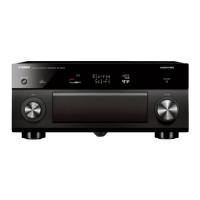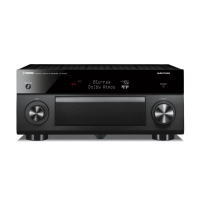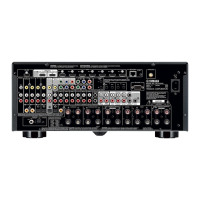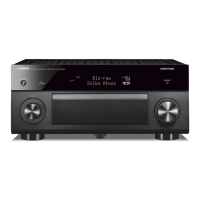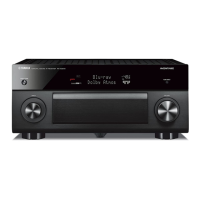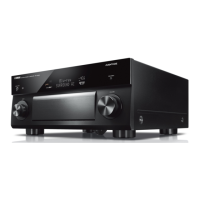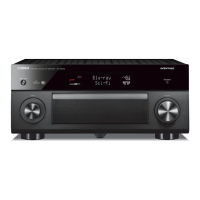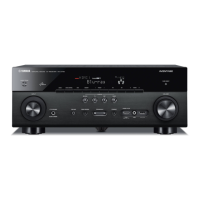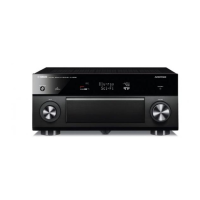Do you have a question about the Yamaha RX-A3020 and is the answer not in the manual?
Overview of the unit's capabilities and supported content.
Step-by-step guide for initial setup and connections.
Customize input source names, icons, and assignments.
Set up one-touch scenes for input, sound, and other settings.
Adjust sound programs and surround decoder settings for optimal audio.
Access and configure various unit settings via the TV screen.
View details about current audio, video, and HDMI signals.
Access advanced system settings for network, system, and zone configurations.
Answers to common user queries regarding operation and features.
Solutions for common problems and error indications.
Definitions of technical terms and audio/video formats used in the manual.
Details on HDMI Control, ARC, and signal compatibility.
List of trademarks and logos associated with the product and technologies.
Technical specifications including input/output jacks, power, and dimensions.
Alphabetical listing of topics and their corresponding page numbers.
Improves musicality of compressed audio content with high-sampling extension.
Enhances video quality through I/P conversion, noise reduction, and scaling.
Connect external amplifiers for higher audio quality and system expansion.
Play audio/video in multiple rooms simultaneously.
Identification and explanation of the unit's front panel components.
Detailed description of controls and jacks inside the front panel door.
Explanation of the indicators and symbols on the unit's front display.
Identification and explanation of the unit's rear panel jacks.
Description of rear panel jacks for antennas, audio, and multi-channel inputs.
Identification and explanation of the unit's remote control buttons.
Detailed description of the remote control's internal buttons and functions.
Step-by-step guide for initial setup and connections.
Instructions for connecting speakers to the unit, including speaker types and layout.
Basic speaker configurations for different channel systems like 9.2+2 and 9.2-channel.
Speaker configurations for 7.1-channel, 5.1-channel, and 2.1-channel systems.
Steps for setting speaker impedance for 6-ohm or 4-ohm speakers.
Diagram and table for connecting speakers, including cable requirements.
Instructions for connecting speaker cables and subwoofers.
Advanced speaker configurations: bi-amp, channel expansion, and multi-zone.
Table of available speaker configurations and power amp assignments for RX-A3020/RX-A2020.
Speaker connection diagrams and tables for 7ch BI-AMP and 7ch BI-AMP +FP configurations.
Speaker connection diagrams for 7ch BI-AMP +FP+RP and 9ch +RP configurations.
Speaker connection diagrams for 9ch +FRONT and 7ch +FP+RP configurations.
Speaker connection diagrams for 7ch +FRONT+1ZONE and 5ch +FRONT+2ZONE configurations.
Speaker connection diagrams for 7ch +1ZONE and 9ch +1ZONE configurations.
Speaker connection diagram for 7ch +2ZONE configuration.
Connecting front speakers for bi-amp and Zone2/3 speakers.
Connecting an external power amplifier and its recommended specifications.
Explanation of various video, audio, and HDMI jacks and cables.
Methods for connecting a TV using HDMI, including HDMI Control and ARC.
Necessary settings for HDMI Control and ARC on the unit and TV.
Connection Method 2: Using HDMI and an audio cable for HDMI Control.
Connection Method 3: Using HDMI and audio cable for TVs without ARC.
Connection Method 4: For TVs without HDMI input jacks, using component, S-video, or composite connections.
Connecting another TV or projector using the unit's HDMI OUT 2 jack.
Connecting video devices like BD/DVD players using HDMI or component video.
Connecting video devices using S-video or composite video connections.
Connecting audio devices like CD players and turntables.
Using the VIDEO AUX jack for temporary connections of game consoles and camcorders.
Instructions for connecting the supplied FM and AM antennas.
Connecting the unit to a network for Internet radio and media server access.
Connecting recording devices to AV OUT jacks and devices with analog multi-channel output.
Connecting devices for SCENE link playback and trigger function compatibility.
Instructions for connecting the power cable and setting the voltage selector.
How to choose the language for the on-screen menu.
Guide to using YPAO for automatic speaker setup and room acoustic optimization.
Selecting measurement options for YPAO: Multi Position vs. Single Measure.
Performing single-measure YPAO and enabling/disabling angle measurement.
Performing angle measurement for YPAO (RX-A3020 only).
Performing multi-measure YPAO, including positioning the microphone.
Completing multi-measure YPAO and performing angle measurements.
Saving YPAO measurement results and checking measurement details.
Reloading previous YPAO adjustments and checking speaker settings.
Understanding and resolving error messages encountered during YPAO setup.
Understanding and addressing warning messages from YPAO setup.
General steps for playing back audio and video sources.
How to select the HDMI OUT jack for signal output.
Using SCENE keys to select input, sound, and other settings with one touch.
Configuring SCENE assignments and selecting items to include in scene settings.
Choosing sound programs, surround decoders, and modes like Pure Direct.
Enjoying stereoscopic sound fields with CINEMA DSP HD³/3D and Virtual CINEMA DSP.
Sound programs suitable for movies (MOVIE THEATER, ENTERTAINMENT categories).
Sound programs suitable for music/stereo playback (CLASSICAL, LIVE/CLUB, STEREO).
Enjoying unprocessed playback and playing back 2-channel sources in multichannel.
Enjoying pure high fidelity sound (Pure Direct) and compressed music with enhanced sound.
Tuning into FM/AM radio stations by frequency or presets.
Registering and selecting favorite radio stations (presets).
Tuning HD Radio stations and displaying HD Radio information.
Holding HD Radio information display and operating HD Radio on TV.
Radio Data System tuning and displaying RDS information.
Operating radio on TV and receiving traffic information.
Browsing preset stations and managing radio settings.
Connecting an iPod to the unit using a USB cable.
Operating iPod content and playback using the TV screen menu.
Operating the iPod using simple play mode or the remote control.
Configuring repeat and shuffle settings for iPod playback.
Connecting a USB storage device and playing back music files.
Operating USB storage device contents and browsing files.
Configuring repeat and shuffle settings for USB storage playback.
Setting up media sharing and playing back music from PCs or NAS.
Operating PC music content and browsing files from media servers.
Configuring repeat and shuffle settings for PC music playback.
Connecting to and listening to Internet radio stations.
Browsing Internet radio stations and managing bookmarks.
Playing back iTunes/iPod music wirelessly using the AirPlay function.
Operating iTunes/iPod playback via AirPlay and configuring playback controls.
Overview of multi-zone function for enjoying audio/video in different rooms.
Preparing the multi-zone system by connecting speakers using internal or external amplifiers.
Connecting a video monitor to play back analog videos in Zone2 or Zone3.
Connecting HDMI-compatible devices for video/audio playback in Zone2 or Zone4.
Operating the unit and devices from another room using remote connections.
Controlling Zone2, Zone3, or Zone4, and selecting input sources.
Other operations for multi-zone, including volume, SCENE, sleep timer, and party mode.
Switching information displayed on the front panel and viewing status on TV.
Accessing and configuring playback settings via the Option menu.
Adjusting Tone Control and Adaptive DRC settings.
Configuring dialogue settings, extended surround, and volume trim.
Adjusting subwoofer trim, enhancer, video modes, and audio select.
Configuring audio modes for stereo/monaural FM radio reception.
Changing input source settings like name, icon, and assignments.
Renaming input sources, setting decoder mode, volume interlock, and video out.
Accessing and configuring SCENE function settings.
Saving, loading, renaming scenes, and controlling external devices via SCENE link.
Selecting scene assignment items and renaming scenes.
Accessing and configuring sound programs and surround decoders.
Settings for sound programs including decode type, DSP level, and delays.
Settings for surround decoders like Dolby Pro Logic IIx and DTS Neo:6.
Accessing and navigating the unit's Setup menu.
Speaker manual setup options including setting pattern, size, and distance.
HDMI, Network, Multi Zone, Function, ECO, and Language settings.
Speaker manual setup: Setting Pattern, Data Copy, and Power Amp Assign.
Speaker configuration for front, center, surround, and surround back speakers.
Speaker configuration for presence, subwoofer, SWFR layout, and extra bass settings.
Speaker Level, Parametric EQ, and Test Tone settings.
Lipsync, Dynamic Range, and Max Volume settings.
Initial Volume, Pure Direct Mode, Adaptive DSP Level, and Analog to Analog Conversion settings.
Video Resolution, Aspect Ratio, and Adjustment settings.
Detail Enhancement, Edge Enhancement, Noise Reduction, and Mosquito NR settings.
HDMI Control, TV Audio Input, ARC, and Standby Sync settings.
HDMI OUT settings, Standby Through, and Network IP Address configuration.
Network Standby, MAC Address Filter, and Network Name settings.
Multi Zone settings: Main Zone, Zone2/3 settings including Volume and Max Volume.
Multi Zone settings: Mono, Zone Scene Rename, Zone Rename, and Zone4 settings.
HDMI OUT2 Assign, Party Mode Set, and Input Assignment settings.
Display settings like Dimmer, Short Message, Wall Paper, and Trigger Output settings.
Target Zone for trigger functions and Memory Guard settings for protection.
ECO settings: Auto Power Down and ECO Mode, and Language selection.
Viewing Audio Signal, Video Signal, and HDMI Monitor information.
Accessing network, system, and zone information.
Changing speaker impedance, remote control sensor, and remote control ID.
Changing FM/AM tuning frequency, TV format, and HDMI monitor check settings.
Backing up/recovering settings, restoring defaults, and updating firmware.
Registering remote control codes for TVs.
Registering remote control codes for playback devices and TV operations.
Programming from other remote controls (learning functions).
Editing device names on the remote control's display.
Enabling macro operations for sequential control of multiple functions.
Programming macro operations for multi-function sequences.
Resetting remote control configurations and clearing learned functions.
Erasing functions assigned by learning and restoring default key assignments.
Instructions for updating the unit's firmware via network or USB.
Overview of the unit's capabilities and supported content.
Step-by-step guide for initial setup and connections.
Customize input source names, icons, and assignments.
Set up one-touch scenes for input, sound, and other settings.
Adjust sound programs and surround decoder settings for optimal audio.
Access and configure various unit settings via the TV screen.
View details about current audio, video, and HDMI signals.
Access advanced system settings for network, system, and zone configurations.
Answers to common user queries regarding operation and features.
Solutions for common problems and error indications.
Definitions of technical terms and audio/video formats used in the manual.
Details on HDMI Control, ARC, and signal compatibility.
List of trademarks and logos associated with the product and technologies.
Technical specifications including input/output jacks, power, and dimensions.
Alphabetical listing of topics and their corresponding page numbers.
Improves musicality of compressed audio content with high-sampling extension.
Enhances video quality through I/P conversion, noise reduction, and scaling.
Connect external amplifiers for higher audio quality and system expansion.
Play audio/video in multiple rooms simultaneously.
Identification and explanation of the unit's front panel components.
Detailed description of controls and jacks inside the front panel door.
Explanation of the indicators and symbols on the unit's front display.
Identification and explanation of the unit's rear panel jacks.
Description of rear panel jacks for antennas, audio, and multi-channel inputs.
Identification and explanation of the unit's remote control buttons.
Detailed description of the remote control's internal buttons and functions.
Step-by-step guide for initial setup and connections.
Instructions for connecting speakers to the unit, including speaker types and layout.
Basic speaker configurations for different channel systems like 9.2+2 and 9.2-channel.
Speaker configurations for 7.1-channel, 5.1-channel, and 2.1-channel systems.
Steps for setting speaker impedance for 6-ohm or 4-ohm speakers.
Diagram and table for connecting speakers, including cable requirements.
Instructions for connecting speaker cables and subwoofers.
Advanced speaker configurations: bi-amp, channel expansion, and multi-zone.
Table of available speaker configurations and power amp assignments for RX-A3020/RX-A2020.
Speaker connection diagrams and tables for 7ch BI-AMP and 7ch BI-AMP +FP configurations.
Speaker connection diagrams for 7ch BI-AMP +FP+RP and 9ch +RP configurations.
Speaker connection diagrams for 9ch +FRONT and 7ch +FP+RP configurations.
Speaker connection diagrams for 7ch +FRONT+1ZONE and 5ch +FRONT+2ZONE configurations.
Speaker connection diagrams for 7ch +1ZONE and 9ch +1ZONE configurations.
Speaker connection diagram for 7ch +2ZONE configuration.
Connecting front speakers for bi-amp and Zone2/3 speakers.
Connecting an external power amplifier and its recommended specifications.
Explanation of various video, audio, and HDMI jacks and cables.
Methods for connecting a TV using HDMI, including HDMI Control and ARC.
Necessary settings for HDMI Control and ARC on the unit and TV.
Connection Method 2: Using HDMI and an audio cable for HDMI Control.
Connection Method 3: Using HDMI and audio cable for TVs without ARC.
Connection Method 4: For TVs without HDMI input jacks, using component, S-video, or composite connections.
Connecting another TV or projector using the unit's HDMI OUT 2 jack.
Connecting video devices like BD/DVD players using HDMI or component video.
Connecting video devices using S-video or composite video connections.
Connecting audio devices like CD players and turntables.
Using the VIDEO AUX jack for temporary connections of game consoles and camcorders.
Instructions for connecting the supplied FM and AM antennas.
Connecting the unit to a network for Internet radio and media server access.
Connecting recording devices to AV OUT jacks and devices with analog multi-channel output.
Connecting devices for SCENE link playback and trigger function compatibility.
Instructions for connecting the power cable and setting the voltage selector.
How to choose the language for the on-screen menu.
Guide to using YPAO for automatic speaker setup and room acoustic optimization.
Selecting measurement options for YPAO: Multi Position vs. Single Measure.
Performing single-measure YPAO and enabling/disabling angle measurement.
Performing angle measurement for YPAO (RX-A3020 only).
Performing multi-measure YPAO, including positioning the microphone.
Completing multi-measure YPAO and performing angle measurements.
Saving YPAO measurement results and checking measurement details.
Reloading previous YPAO adjustments and checking speaker settings.
Understanding and resolving error messages encountered during YPAO setup.
Understanding and addressing warning messages from YPAO setup.
General steps for playing back audio and video sources.
How to select the HDMI OUT jack for signal output.
Using SCENE keys to select input, sound, and other settings with one touch.
Configuring SCENE assignments and selecting items to include in scene settings.
Choosing sound programs, surround decoders, and modes like Pure Direct.
Enjoying stereoscopic sound fields with CINEMA DSP HD³/3D and Virtual CINEMA DSP.
Sound programs suitable for movies (MOVIE THEATER, ENTERTAINMENT categories).
Sound programs suitable for music/stereo playback (CLASSICAL, LIVE/CLUB, STEREO).
Enjoying unprocessed playback and playing back 2-channel sources in multichannel.
Enjoying pure high fidelity sound (Pure Direct) and compressed music with enhanced sound.
Tuning into FM/AM radio stations by frequency or presets.
Registering and selecting favorite radio stations (presets).
Tuning HD Radio stations and displaying HD Radio information.
Holding HD Radio information display and operating HD Radio on TV.
Radio Data System tuning and displaying RDS information.
Operating radio on TV and receiving traffic information.
Browsing preset stations and managing radio settings.
Connecting an iPod to the unit using a USB cable.
Operating iPod content and playback using the TV screen menu.
Operating the iPod using simple play mode or the remote control.
Configuring repeat and shuffle settings for iPod playback.
Connecting a USB storage device and playing back music files.
Operating USB storage device contents and browsing files.
Configuring repeat and shuffle settings for USB storage playback.
Setting up media sharing and playing back music from PCs or NAS.
Operating PC music content and browsing files from media servers.
Configuring repeat and shuffle settings for PC music playback.
Connecting to and listening to Internet radio stations.
Browsing Internet radio stations and managing bookmarks.
Playing back iTunes/iPod music wirelessly using the AirPlay function.
Operating iTunes/iPod playback via AirPlay and configuring playback controls.
Overview of multi-zone function for enjoying audio/video in different rooms.
Preparing the multi-zone system by connecting speakers using internal or external amplifiers.
Connecting a video monitor to play back analog videos in Zone2 or Zone3.
Connecting HDMI-compatible devices for video/audio playback in Zone2 or Zone4.
Operating the unit and devices from another room using remote connections.
Controlling Zone2, Zone3, or Zone4, and selecting input sources.
Other operations for multi-zone, including volume, SCENE, sleep timer, and party mode.
Switching information displayed on the front panel and viewing status on TV.
Accessing and configuring playback settings via the Option menu.
Adjusting Tone Control and Adaptive DRC settings.
Configuring dialogue settings, extended surround, and volume trim.
Adjusting subwoofer trim, enhancer, video modes, and audio select.
Configuring audio modes for stereo/monaural FM radio reception.
Changing input source settings like name, icon, and assignments.
Renaming input sources, setting decoder mode, volume interlock, and video out.
Accessing and configuring SCENE function settings.
Saving, loading, renaming scenes, and controlling external devices via SCENE link.
Selecting scene assignment items and renaming scenes.
Accessing and configuring sound programs and surround decoders.
Settings for sound programs including decode type, DSP level, and delays.
Settings for surround decoders like Dolby Pro Logic IIx and DTS Neo:6.
Accessing and navigating the unit's Setup menu.
Speaker manual setup options including setting pattern, size, and distance.
HDMI, Network, Multi Zone, Function, ECO, and Language settings.
Speaker manual setup: Setting Pattern, Data Copy, and Power Amp Assign.
Speaker configuration for front, center, surround, and surround back speakers.
Speaker configuration for presence, subwoofer, SWFR layout, and extra bass settings.
Speaker Level, Parametric EQ, and Test Tone settings.
Lipsync, Dynamic Range, and Max Volume settings.
Initial Volume, Pure Direct Mode, Adaptive DSP Level, and Analog to Analog Conversion settings.
Video Resolution, Aspect Ratio, and Adjustment settings.
Detail Enhancement, Edge Enhancement, Noise Reduction, and Mosquito NR settings.
HDMI Control, TV Audio Input, ARC, and Standby Sync settings.
HDMI OUT settings, Standby Through, and Network IP Address configuration.
Network Standby, MAC Address Filter, and Network Name settings.
Multi Zone settings: Main Zone, Zone2/3 settings including Volume and Max Volume.
Multi Zone settings: Mono, Zone Scene Rename, Zone Rename, and Zone4 settings.
HDMI OUT2 Assign, Party Mode Set, and Input Assignment settings.
Display settings like Dimmer, Short Message, Wall Paper, and Trigger Output settings.
Target Zone for trigger functions and Memory Guard settings for protection.
ECO settings: Auto Power Down and ECO Mode, and Language selection.
Viewing Audio Signal, Video Signal, and HDMI Monitor information.
Accessing network, system, and zone information.
Changing speaker impedance, remote control sensor, and remote control ID.
Changing FM/AM tuning frequency, TV format, and HDMI monitor check settings.
Backing up/recovering settings, restoring defaults, and updating firmware.
Registering remote control codes for TVs.
Registering remote control codes for playback devices and TV operations.
Programming from other remote controls (learning functions).
Editing device names on the remote control's display.
Enabling macro operations for sequential control of multiple functions.
Programming macro operations for multi-function sequences.
Resetting remote control configurations and clearing learned functions.
Erasing functions assigned by learning and restoring default key assignments.
Instructions for updating the unit's firmware via network or USB.
| Receiver type | Surround |
|---|---|
| Frequency range | 20 - 20000 Hz |
| Audio output channels | 9.2 channels |
| Signal-to-Noise Ratio (SNR) | 8 dB |
| Total Harmonic Distortion (THD) | 0.06 % |
| Dynamic power per channel (4 Ohm) | 295 W |
| Dynamic power per channel (8 Ohm) | 175 W |
| Power output per channel (1KHz@6 Ohm) | 230 W |
| Power output per channel (20-20KHz@8 Ohm) | 150 W |
| HDMI in | 8 |
| Composite video in | 5 |
| USB ports quantity | 1 |
| Digital audio coaxial in | 3 |
| Component video (YPbPr/YCbCr) in | 4 |
| Connectivity technology | Wired |
| Speakers connectivity type | - |
| Wi-Fi | No |
| Ethernet LAN | Yes |
| Supported radio bands | AM, FM |
| Product color | Black |
| Audio decoders | Dolby Digital Plus, Dolby Pro Logic IIx, Dolby TrueHD, DTS-HD Master Audio |
| Apple docking compatibility | Not supported |
| Power consumption (standby) | 0.3 W |
| Depth | 467 mm |
|---|---|
| Width | 435 mm |
| Height | 192 mm |
| Weight | 19900 g |

